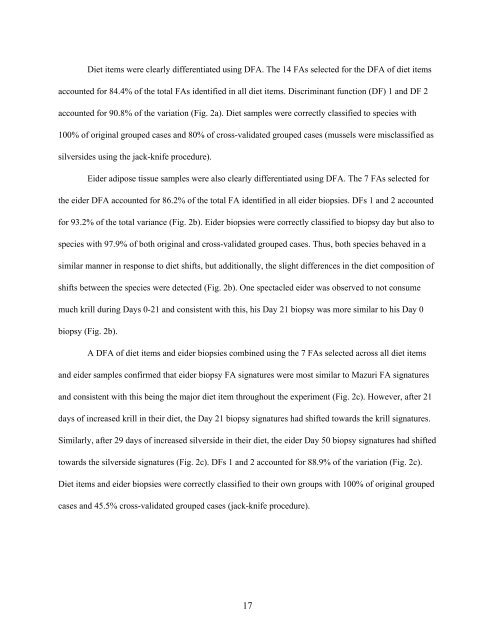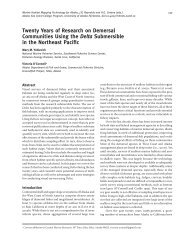724_Final Report.pdf - North Pacific Research Board
724_Final Report.pdf - North Pacific Research Board
724_Final Report.pdf - North Pacific Research Board
You also want an ePaper? Increase the reach of your titles
YUMPU automatically turns print PDFs into web optimized ePapers that Google loves.
Diet items were clearly differentiated using DFA. The 14 FAs selected for the DFA of diet items<br />
accounted for 84.4% of the total FAs identified in all diet items. Discriminant function (DF) 1 and DF 2<br />
accounted for 90.8% of the variation (Fig. 2a). Diet samples were correctly classified to species with<br />
100% of original grouped cases and 80% of cross-validated grouped cases (mussels were misclassified as<br />
silversides using the jack-knife procedure).<br />
Eider adipose tissue samples were also clearly differentiated using DFA. The 7 FAs selected for<br />
the eider DFA accounted for 86.2% of the total FA identified in all eider biopsies. DFs 1 and 2 accounted<br />
for 93.2% of the total variance (Fig. 2b). Eider biopsies were correctly classified to biopsy day but also to<br />
species with 97.9% of both original and cross-validated grouped cases. Thus, both species behaved in a<br />
similar manner in response to diet shifts, but additionally, the slight differences in the diet composition of<br />
shifts between the species were detected (Fig. 2b). One spectacled eider was observed to not consume<br />
much krill during Days 0-21 and consistent with this, his Day 21 biopsy was more similar to his Day 0<br />
biopsy (Fig. 2b).<br />
A DFA of diet items and eider biopsies combined using the 7 FAs selected across all diet items<br />
and eider samples confirmed that eider biopsy FA signatures were most similar to Mazuri FA signatures<br />
and consistent with this being the major diet item throughout the experiment (Fig. 2c). However, after 21<br />
days of increased krill in their diet, the Day 21 biopsy signatures had shifted towards the krill signatures.<br />
Similarly, after 29 days of increased silverside in their diet, the eider Day 50 biopsy signatures had shifted<br />
towards the silverside signatures (Fig. 2c). DFs 1 and 2 accounted for 88.9% of the variation (Fig. 2c).<br />
Diet items and eider biopsies were correctly classified to their own groups with 100% of original grouped<br />
cases and 45.5% cross-validated grouped cases (jack-knife procedure).<br />
17



